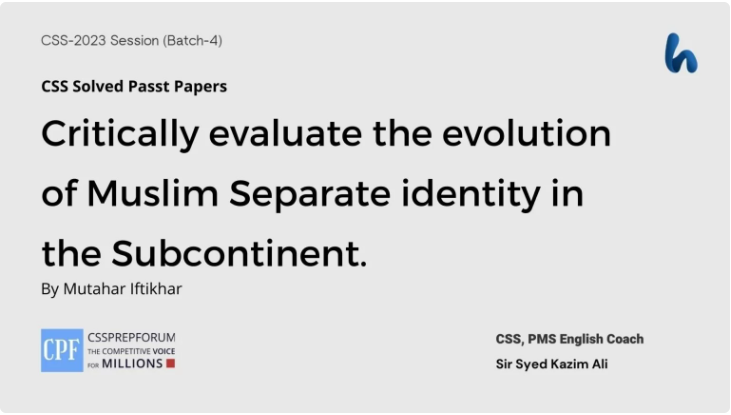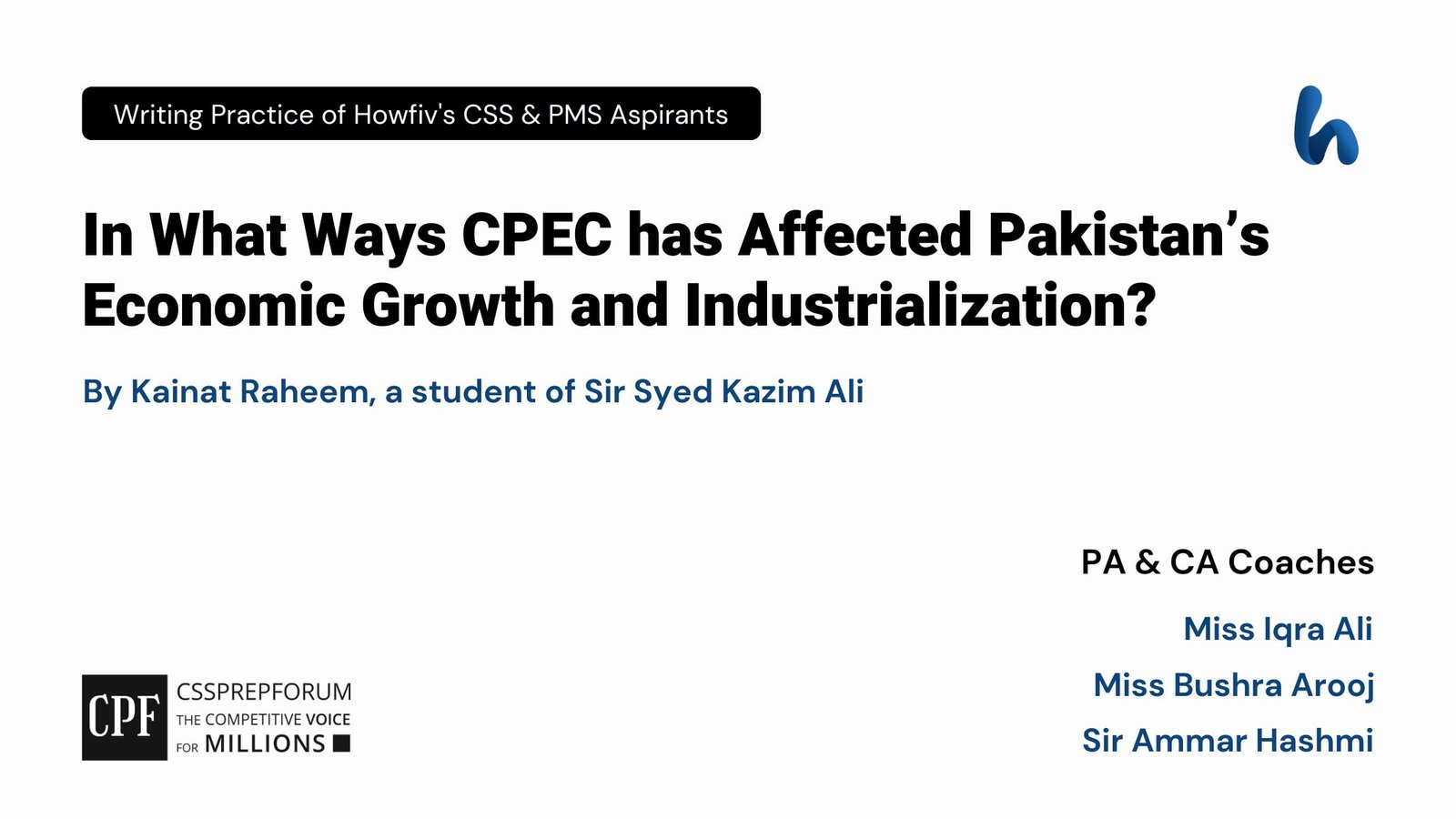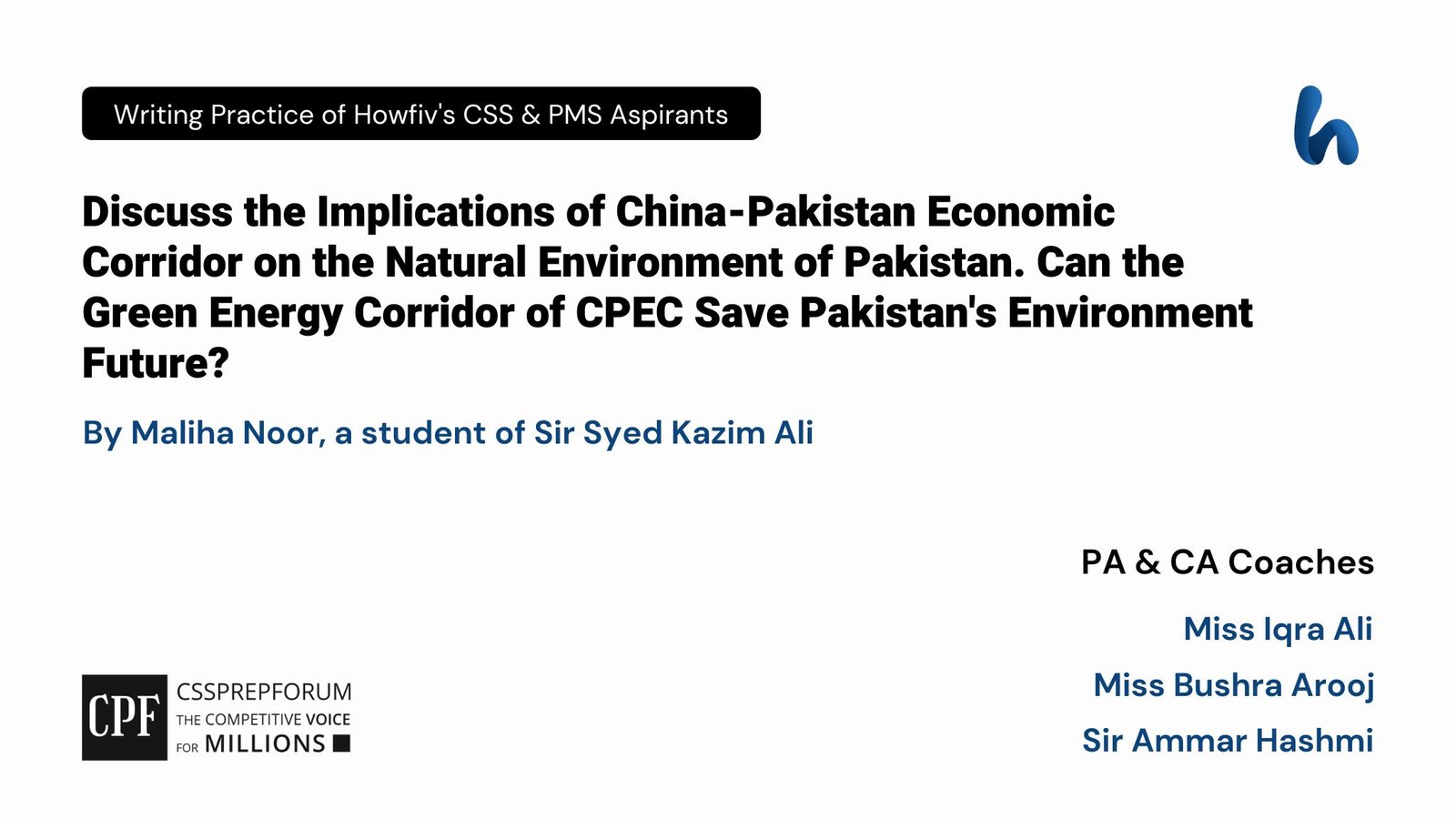CSS Solved Pakistan Affairs Past Papers | Critically Evaluate the Evolution of Muslim Separate Identity in the Sub-Continent.
The following question of CSS Pakistan Affairs 2021 is solved by Mutahar Iftikhar under the supervision of Miss Nirmal Hasni. She learnt how to attempt 20 marks question and essay writing from Sir Syed Kazim Ali, Pakistan’s best CSS and PMS English essay and precis teacher with the highest success rate of his students. This solved past paper question is attempted on the pattern taught by Sir to his students, scoring the highest marks in compulsory and optional subjects for years, and uploaded to help aspirants understand how to crack a topic or question, how to write relevantly, what coherence is, and how to include and connect ideas, opinions, and suggestions to score the maximum.

Question’s Breakdown:
In this Question, the examiner asks you to critically analyze how a separate Muslim identity evolved in the sub-continent. Hence, you must divide the history into phases and then identify the major developments that significantly influence the evolution of separateness among Muslims. Then, you may elaborate on each phase, pointing out how it contributed to the evolution or not. Afterwards, you must give a critical analysis before concluding the answer and maintain coherency and relevancy throughout your writeup.
Outline
Introduction:
Though the advent of Islam established Muslim society in the sub-continent, the sense of separatism evolved through social, religious, and political movements expanding over a millennium. Reprimanding of Deen-i-Elahi by Mujadid Alif Sani on religious grounds to Muslim’s political renaissance by Sir Syed Ahmed Khan gave the Indian sub-continent Muslims a separate identity, which resulted in Pakistan eventually.
Historical review of the then prevailed condition among Muslims:
- Swift early headways of Islam in the subcontinent
- Deen-e Elahi: the emergence of a homogeneous society
- Indifference to the Quran and the Shariah
- Hindus demographic dominance
Evolution of Muslim separate identity through religious and political movements:
- Religious movements
- Mujadid Alif Sani
- Shah Waliullah
- Syed Ahmad Shaheed
- Political movements
- Independence war
- Assuring Muslim representation in the legislative council
- Khilafat movements
- 1937 elections
- Lahore resolution
The culmination of the evolution of Muslim separate identity in the sub-continent: Pakistan
Critical Analysis:
Conclusion:

Answer to the Question
Introduction
Though the advent of Islam established Muslim society in the sub-continent, the sense of separatism evolved through social, religious, and political movements expanding over a millennium. Reprimanding of Deen-i-Elahi by Mujadid Alif Sani on religious grounds to Muslim’s political renaissance by Sir Syed Ahmed Khan gave the Indian sub-continent Muslims a separate identity, which resulted in Pakistan eventually. The first half of the millennia saw Islam’s swift inroads, the establishment of the first Muslim dominion in the subcontinent, and- later- irrelevance to Islamic injunctions and usual intermingling among the Hindus and the Muslims. Then, various religious movements initiated Islam’s social religious emergence and asserted the true Muslimness in contemporary society. After the fall of the Muslim Empire and violent struggle to regain it, socially degraded Muslims’ political resurgence ensued with various leaders stepping in to secure the Islamic existence in the Indian subcontinent, which eventually culminated in the making of Pakistan- a separate Muslim homeland. This answer comprehensively discusses Muslims’ religious and political struggles to assert their separate identity in the sub-continent.
Islamic imprints in the subcontinent are ancient, but they made swift inroads with the invasion of Muhammad Bin Qasim and the subsequent establishment of the first Islamic state in India. Muslims, directly or indirectly, ruled the vast area of the sub-continent for nearly a millennium. In that period, a large Indian population embraced Islam. With predominantly Muslim rulers at the helm, they enjoyed numerous privileges. Meanwhile, the rise of the Sikhs and Mahrattas forced the Muslim rulers to adopt conciliatory policies toward them, blurring the distinctions and honours of being a Muslim. Hence, indifference to the Quran and Shariah; intermarriages of the Hindus and Muslims; and irregularities- like Deen-e-Elahi- became more pronounced in society, marring the essence and spirit of an Islamic community. Consequently, the threat of Hindus demographic dominance slowly engulfing the budding flower of Islam and the Muslims’ desire to preserve their religion invoked a strong response that gave birth to a separate Muslim identity.
Where the adoption of Deen-e-Elahi and conciliatory political policies towards non-Muslims proved helpful, it gave birth to numerous religious movements aimed at sharpening the Muslims’ concepts of the religion and Shariah. Mujadid Alif Sani, with his disciples, launched a religious rebuttal movement focused on un-Islamic practices then frequently exercised in society. He openly condemned the intermingling the religions and abolition of Jizya on non-Muslims. Moreover, he indefatigably wrote on various topics related to Islam, calling Muslims back to the roots of Islam and sharpening the divide of a Hindu and Muslim society. After him, Shah Waliullah started his movement intending to unite socially and politically scattered Muslims under the banner of Islam. After that, Syed Ahmad Shaheed went on a Jihad mission to establish an Islamic state based on religious injunction across northern India. Though the religious movements were only partially successful, they did the work of giving Islam a strong foothold in the Indian sub-continent. Contrary to the aspirations of the Hindus, Sikhs, and Mahrattas, Islam survived the early existential onslaught owing to the far-sighted and utterly delved Islamic scholars.
Next came the political ordeal for the Indian Muslims after the war of Independence in 1857, where they were deprived of social, religious, economic, and political rights. With their British accomplices, the Hindus cornered their language, literature, culture, and religion. Hardly was there a field where Muslims thrived. In the disadvantaged backdrop, the Muslim leaders realized the gravity of the situation and worked on Muslims’ religious and modern education because they knew it was the only way to rival the Hindus well-entrenched in the then social structure. The M.A.O. College and Nadwa-tul-ulema gave birth to the visionary leadership, who initiated the political movement refining the concept of a separate Muslim identity to convince the whole world.
Moreover, during the century-long political struggle, various events heralding the Hindus’ nefarious aims strengthened the Muslim leadership’s resolve. Over time, though the strategies and methods varied, the ultimate objective of acquiring safeguards for the Muslims and Islam in the subcontinent persisted. The establishment of the Muslim League, a counterpart to the Indian National Congress, in 1906 proved to be a watershed moment in the political struggle, giving a legitimate face to the Muslims’ insecurities in India. Afterwards, the back-stabbing of the Khilafat Movement and open refutation of giving the Indian Muslims their due in electoral assemblies, and- later- 1937-39 Congress rule overly detrimental to the existence of Islam in India convinced Muslims to look for another alternative to assert their separate identity. Consequently, the pioneers of a separate electorate and safeguards for the Indian Muslims changed their demands to a separate homeland, resulting in the Lahore Resolution.
The movement that started with the dusting of the Hindu influence over the Islamic community culminated in the demand for a separate homeland for a distinct nation, Muslims. Therefore, the two-nation theory is the ultimate expression of a separate Muslim identity, with the state of Pakistan as its embodiment.
Critical Analysis:
The definition of a separate Muslim identity took multiple religious, social, and political movements expanding over five centuries; however, its assertion was relatively swift. The need for a separate Muslim identity arose with mounting anomalies in Islam under the influence of predominantly Hinduism and Buddhism. Later, Muslims were hard-pressed to look for their survival in India. In response, the Muslims vehemently strived to save themselves and their religion. The revolution of a separate Muslim identity is the result of that struggle.
Conclusion:
To sum up, a sense of separatism among the Indian Muslims evolved with the various religiopolitical struggles fixated on the survival of Islam in the subcontinent. It started with acting on the true injunctions of Islam and spiralled into the establishment of an Islamic state based on the Quranic injunctions. Then, after the failure of the War of Independence, Muslims bereft of any social, political, economic standing again found themselves under the improper influence of others, pushing them to strive for a separate Muslim identity. Under the different hostile environments, the Muslims responded with the same zeal. However, their idea of an independent nation proved successful in winning them security earlier and a separate homeland later.
CSS Solved Past Papers’ Essays
Looking for the last ten years of CSS and PMS Solved Essays and want to know how Sir Kazim’s students write and score the highest marks in the essays’ papers? Then, click on the CSS Solved Essays to start reading them.
CSS Solved Essays












